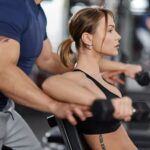Are you curious about how to be fit without exercise? While regular physical activity is crucial for maintaining a healthy lifestyle, there are other ways to stay fit and healthy without hitting the gym or going for a run. In this article, we will explore the concept of staying fit without traditional exercise and provide practical tips to achieve overall fitness through mindful eating, an active lifestyle, proper rest and sleep, stress management, hydration, and body positivity.
Maintaining a healthy and balanced diet plays a significant role in supporting overall fitness. We will delve into the importance of mindful eating and provide tips on making healthy food choices that nourish the body and promote wellness. Additionally, we will discuss the benefits of an active lifestyle and how incorporating movement into daily activities can contribute to staying fit without dedicated workout sessions.
Furthermore, understanding the role of proper rest and sleep in maintaining physical health will be highlighted. Stress management techniques and the connection between stress and fitness will also be explored as part of achieving overall wellness. Hydration’s impact on fitness and embracing body positivity as part of overall wellness will also be discussed in detail. Stay tuned for practical insights on achieving fitness without traditional exercise.
Mindful Eating
Maintaining a healthy and balanced diet is essential for supporting overall fitness, even without traditional exercise. Mindful eating involves being more aware of what and how much you are eating, as well as paying attention to your body’s hunger and fullness cues. One way to practice mindful eating is by focusing on the sensory experience of eating, such as the taste, texture, and aroma of your food. This can help prevent overeating and promote better digestion.
When it comes to mindful eating, it’s important to prioritize whole, nutrient-dense foods such as fruits, vegetables, lean proteins, whole grains, and healthy fats. These foods provide essential nutrients that support overall health and fitness. Additionally, mindful eating involves being more conscious of portion sizes and avoiding mindless snacking or emotional eating. By making thoughtful food choices and paying attention to portion control, you can better support your fitness goals without relying solely on traditional exercise.
In addition to focusing on the types of foods you consume, mindful eating also encourages paying attention to the way in which you eat. This includes slowing down during meals, chewing food thoroughly, and avoiding distractions such as watching TV or using electronic devices while eating. By practicing mindful eating habits like these, you can cultivate a healthier relationship with food and contribute to your overall fitness even in the absence of regular exercise.
| Mindful Eating Tips | Benefits |
|---|---|
| Focus on sensory experience | Prevents overeating |
| Prioritize whole foods | Supports overall health |
| Avoid mindless snacking | Promotes portion control |
Active Lifestyle
In today’s busy world, finding time to dedicate to traditional exercise routines can be challenging. However, incorporating movement into our daily activities and making small lifestyle changes can contribute significantly to overall fitness. An active lifestyle doesn’t necessarily mean spending hours at the gym; it’s about finding ways to keep moving throughout the day.
One way to incorporate more movement into your daily routine is by choosing to walk or bike instead of driving for short distances. Taking the stairs instead of the elevator, doing household chores, or even engaging in active leisure activities like gardening or dancing are all effective ways to stay active without a structured workout.
Small changes like standing up and stretching every hour while at work or taking short walking breaks throughout the day can also make a significant impact on overall fitness.
Research has shown that sitting for long periods of time can have detrimental effects on health, regardless of whether a person meets their daily exercise requirements. Incorporating movement into your daily life not only contributes to burning extra calories but also helps with improving circulation, boosting energy levels, and reducing the risk of chronic diseases associated with a sedentary lifestyle. By making small habitual changes over time, individuals can achieve an active lifestyle that supports their overall physical well-being.
| Benefit | Description |
|---|---|
| Burning Calories | Making small movements throughout the day contributes to burning extra calories. |
| Improved Circulation | Moving regularly helps improve blood flow and circulation in the body. |
| Reduced Risk of Chronic Diseases | An active lifestyle helps reduce the risk of developing chronic diseases associated with a sedentary lifestyle. |
Proper Rest and Sleep
Quality Sleep
Quality sleep is essential for overall health and fitness. During sleep, the body repairs and rejuvenates itself, allowing for proper physical and mental function. It is recommended to aim for 7-9 hours of uninterrupted sleep each night. Creating a comfortable sleep environment, such as a cool, dark, and quiet room, can contribute to better quality sleep.
Rest and Recovery
In addition to quality sleep, incorporating rest and recovery into your routine is crucial for staying fit without traditional exercise. Rest days for both physical and mental recovery are important, especially when engaging in activities that involve physical strain. Overtraining or pushing the body beyond its limits can lead to exhaustion, decreased performance, increased risk of injury, and overall decline in fitness.
Circadian Rhythm
Understanding your body’s natural circadian rhythm can help optimize rest and sleep patterns. The circadian rhythm is the body’s internal clock that regulates the sleep-wake cycle. Consistency in sleep schedules can help regulate this rhythm, leading to improved quality of rest. Additionally, avoiding stimulants like caffeine close to bedtime can promote better sleep quality.
By prioritizing proper rest and understanding its role in overall health and fitness, individuals can achieve wellness without solely relying on traditional forms of exercise. Incorporating quality sleep, allowing for adequate rest and recovery periods, and respecting the body’s natural circadian rhythm are key components in maintaining fitness without intense physical activity.
Stress Management
When it comes to maintaining overall fitness without traditional exercise, managing stress plays a crucial role. Chronic stress can have negative effects on both physical and mental health, making it important to find effective ways to minimize and cope with stress. Here are some techniques for managing stress that can contribute to your overall fitness:
1. Meditation and Mindfulness: Engaging in regular meditation or mindfulness practices can help reduce stress levels, promote relaxation, and improve overall well-being.
2. Physical Activity: Incorporating light physical activities such as walking, yoga, or gardening can help alleviate stress by releasing endorphins and providing a healthy distraction from worries.
3. Time Management: Effective time management skills can help reduce stress by allowing for a better balance between work, personal life, and leisure activities.
By implementing these techniques into your daily routine, you can better manage the impact of stress on your body and mind, ultimately contributing to your overall fitness without having to engage in traditional exercise routines. Remember that taking care of your mental health is just as important as taking care of your physical health.
Hydration
Benefits of Proper Hydration
Staying well-hydrated offers numerous benefits for overall health and fitness. Adequate hydration can help improve energy levels, reduce fatigue, and enhance athletic performance. It also supports healthy skin by keeping it moisturized and can aid in weight management by promoting satiety.
How Much Water Is Enough?
The recommended daily water intake varies depending on factors such as age, gender, activity level, and climate. Generally, it is suggested that individuals aim to consume at least eight 8-ounce glasses of water per day, which is roughly equivalent to about 2 liters or half a gallon. However, individual needs may differ, so it’s important to pay attention to thirst cues and adjust fluid intake accordingly.
Strategies for Staying Hydrated
Incorporating strategies to ensure proper hydration can be simple yet effective. Carrying a reusable water bottle throughout the day serves as a visual reminder to drink water regularly. Infusing water with fruits or herbs can also make hydration more enjoyable for those who struggle with plain water consumption. Additionally, consuming hydrating foods with high water content such as cucumbers, watermelon, or oranges can contribute to overall fluid intake.
Body Positivity
Embracing a positive body image and practicing self-love are essential components of overall wellness. Body positivity is about recognizing and accepting the uniqueness of our bodies, regardless of shape, size, or appearance. It is a mindset that promotes self-acceptance and appreciation for what our bodies can do rather than solely focusing on their physical attributes.
Here are some tips for embracing body positivity and integrating self-love into your wellness routine:
- Practice self-affirmations: Start your day by speaking positive affirmations to yourself in the mirror. Affirmations such as “I am strong,” “I am beautiful,” or “I am worthy” can help boost your confidence and promote a positive body image.
- Surround yourself with positivity: Seek out social media accounts, books, podcasts, or communities that promote body positivity and diversity. Surrounding yourself with uplifting content can help reshape your mindset towards self-love and acceptance.
- Engage in activities that make you feel good: Whether it’s dancing, yoga, painting, or spending time in nature, engaging in activities that bring you joy and make you feel good can improve your overall well-being and foster a positive relationship with your body.
By embracing body positivity and practicing self-love, you can enhance your overall wellness and fitness without traditional exercise. Remember that true fitness goes beyond physical appearance and encompasses mental, emotional, and spiritual well-being.
Conclusion
In conclusion, achieving fitness without traditional exercise is possible through mindful eating, an active lifestyle, proper rest and sleep, stress management, hydration, and body positivity. By focusing on maintaining a healthy and balanced diet, incorporating movement into daily activities, prioritizing rest and sleep, managing stress, staying hydrated, and embracing a positive body image, individuals can support their overall fitness without engaging in formal exercise routines.
It’s important to remember that physical fitness is not solely the result of intense workouts at the gym. By making small lifestyle changes and being mindful of our everyday habits, we can contribute to our overall health and wellness. Prioritizing self-care and taking a holistic approach to fitness can lead to long-term benefits for both our physical and mental well-being.
Ultimately, staying fit without traditional exercise requires a balanced approach that takes into account all aspects of our well-being. By following these tips and incorporating them into our daily lives, we can achieve fitness without the need for intensive workout sessions. Embracing this holistic mindset towards fitness can lead to healthier habits and long-lasting results.
Frequently Asked Questions
Can You Get Fit Without Exercise?
It is very difficult to get fit without exercise. Exercise is a crucial component in improving cardiovascular health, increasing muscle strength, and maintaining a healthy weight. While some changes in diet can lead to weight loss, overall fitness and health require physical activity.
How Do I Go From No Exercise to Fit?
Going from no exercise to being fit requires a gradual approach. Begin by incorporating light exercise into your daily routine, such as taking short walks or trying out beginner-level workout videos. As you build endurance and strength, gradually increase the intensity and duration of your workouts.
How Can I Shape My Body Without Exercise?
Shaping your body without exercise can be challenging, but it is possible to improve your physique through mindful eating habits and lifestyle changes. Focus on consuming nutritious, whole foods and avoiding processed snacks and sugary drinks.
Additionally, practicing good posture and engaging in activities that promote flexibility, such as yoga or Pilates, can help improve your overall body shape even without strenuous exercise.

Passionate about providing useful information to anyone with an interest in the field of Personal Training, I strive to pass on to our readers quality information and to answer any questions about Personal Trainers, the work they do and how to become one.





